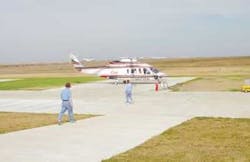Gulf of Mexico
Deep shelf central to El Paso's plans
El Paso Production Co.'s plans for 2003 and 2004 reflect the company's continued enthusiasm about deep gas on the Gulf of Mexico's shallow shelf.
Deep gas will be the bread and butter of the Gulf of Mexico, according to Rodney Erskine, president of El Paso Production Co.
"I'm extremely excited about the deep shelf," he recently told the Petroleum Equip- ment Suppliers Association in Houston.
Gas continues to drive the company's GoM activities.
"The Gulf of Mexico has been a great place for us," Erskine said. "We're going to stay on the shelf."
El Paso treats "drill deeper" as gospel, and he has before said the company strives to be the "deep tight rock kings of the world." The company's gem is its South Timbalier block 204 development.
"The deepwater Gulf of Mexico is just not a game for us, so we're not into that," he said. "I can't make the numbers work out there."
Instead of expending the cash to drill in deepwater and wait so long before a well can come onstream, El Paso would rather focus on the GoM's deep shelf, where oil companies haven't focused the drill bit, Erskine said.
Adding an in-house seismic reprocessing team to the company's lineup has improved the success rate for deep wells, he said.
"It's reduced our risks significantly," he said.
The company put its mean reserves at 250 bcf for its 46 deep shelf prospects between 15,000 and 20,000 ft, with water depths not exceeding 300 ft. The gross potential of the area is 11.2 tcf, Erskine said.
Securing the industry in 6,000+ ft of water
Operators and service companies are becoming comfortable with working in increasing water depths, but Dennis Calkins, J. Ray McDermott division manager for marine projects, wonders whether the industry should feel so secure in these deeper waters.
While water depths up to 3,000 ft no longer seem to faze oil companies, the leapfrog into depths beyond 6,000 ft of water has been posing puzzles for installation companies, he told attendees at the International Mooring Sem-inar 2003 in Houston in February. As installations move into deeper water, Calkins said, companies need to upgrade equipment to make it incrementally better. Moving beyond 6,000 ft of water may reach a company's capacity to upgrade equipment without major investments, he said during the event sponsored by BexcoRopes, Bridon International, Vicinay Cadenas, and Vryhof Anchors.
Spending money on new equipment can be "harder to justify," he said, adding current concerns about going deeper probably are not a problem.
"The industry has a way of adapting," he said. Another session focused on mooring FPSOs in the Gulf of Mexico.
More onstream in 2003
The Minerals Management Service expects up to five more deepwater Gulf of Mexico projects to go onstream in 2003 than in 2002.
Fourteen new deepwater projects began production in 2002, joining the 51 already in production for a total of 65 deepwater producing projects.
"Deepwater development projects continue at a fast pace and the 14 new projects in the Gulf of Mexico, include 11 that were subsea production systems that tied back to another project," GoM Regional Director Chris C. Oynes said.
The MMS expects 19 projects to go onstream this year. Some, like Boris, are already onstream.
null
This raises the total number of subsea projects to 41 out of the 65 total deep-water projects. Three of the new deep-water starts utilized a spar as a produc- tion system.
"We expect a significant rise in the number of deepwater projects that will start production in the year 2003 – perhaps as many as 19," he said.
"Calendar year 2002 was a year of significant deepwater activity in the Gulf of Mexico despite the general downturn in drilling. Twelve new deepwater discoveries were made, and three of these were in 8,000 ft or greater water depths," Oynes said.
Rowan Co. subsidiary Era Aviation Inc. opened its new 36-acre facility in Port Fourchon, Louisiana. "The base was built as close as possible to deepwater activity in the Gulf of Mexico," Al Meyer, senior vice president and manager of Era's Gulf Coast division, said. Era has four S61N and two S223L 19-passenger helicopters to serve deepwater facilities, and according to Meyer, the company plans to augment the fleet with a new $15-million S92. "The larger helicopters have the range and the payload to serve rigs 200 miles offshore on a single tank of fuel and to return to the base with safety reserves in the tank," he said.


